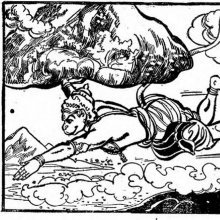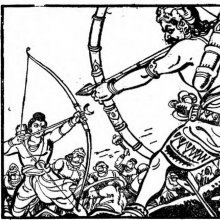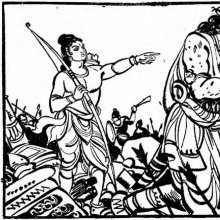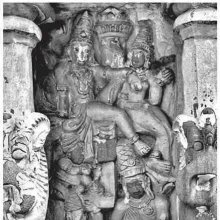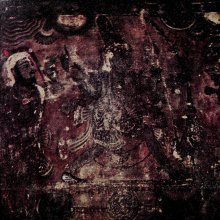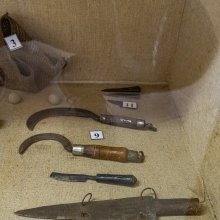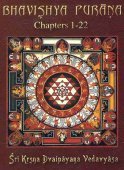Weapon: 2 definitions
Introduction:
Weapon means something in Hinduism, Sanskrit, the history of ancient India. If you want to know the exact meaning, history, etymology or English translation of this term then check out the descriptions on this page. Add your comment or reference to a book if you want to contribute to this summary article.
Images (photo gallery)
(+55 more images available)
In Hinduism
Shaktism (Shakta philosophy)
Source: Brill: Śaivism and the Tantric Traditions (shaktism)Worship of weapons with flowers, perfume and food, (adapted from the pre-existing Vedic model of military festivities), formed a part of the Navarātra Tantric ritual (an autumnal festival of the warrior goddess Caṇḍikā).—Various 5th century sources refer to rituals such as the worship of weapons, for example: Viṣṇudharmottarapurāṇa 2.158.6cd–7, Agnipurāṇa 267.13cd–16ab (repeating Viṣṇudharmottara); Varāhapurāṇa cited in the Kṛtyaratnākara, pp. 364–365.

Shakta (शाक्त, śākta) or Shaktism (śāktism) represents a tradition of Hinduism where the Goddess (Devi) is revered and worshipped. Shakta literature includes a range of scriptures, including various Agamas and Tantras, although its roots may be traced back to the Vedas.
India history and geography
Source: archive.org: Hindu Mathematics (History)Books on the knowledge of Weapons were translated from Sanskrit and transmitted to Arab literature.—The foundations of Arabic literature and science were laid between 750-850 A.D. This was done chiefly with the aid of foreigners and with foreign material. The bulk of their narrative literature came to the Arabs in translation from Persian. Books on the science of war, the knowledge of weapons, the veterinary art, falconry, and the various methods of divination, and some books on medicine were translated from Sanskrit and Persian. They got the exact sciences from Greece and India.

The history of India traces the identification of countries, villages, towns and other regions of India, as well as mythology, zoology, royal dynasties, rulers, tribes, local festivities and traditions and regional languages. Ancient India enjoyed religious freedom and encourages the path of Dharma, a concept common to Buddhism, Hinduism, and Jainism.
See also (Relevant definitions)
Query error!
Full-text (+3311): Ayudha, Astra, Brahmastra, Vajra, Gada, Cakra, Shataghni, Trishula, Musala, Bhushundi, Tomara, Heti, Pasha, Ankusha, Indrayudha, Shastra, Pattisha, Vajrayudha, Shula, Praharana.
Relevant text
Search found 411 books and stories containing Weapon, Weapons, The weapon; (plurals include: Weapons, Weaponses, The weapons). You can also click to the full overview containing English textual excerpts. Below are direct links for the most relevant articles:
Nitiprakasika (Critical Analysis) (by S. Anusha)
Kathasaritsagara (cultural study) (by S. W. Chitale)
Types of Weapons < [Chapter 2 - Political conditions]
Description of Gods in the Kathasaritsagara < [Chapter 5 - Religion and Philosophy]
Social Conditions—Introduction < [Chapter 4 - Social Conditions]
Mahabharata (English) (by Kisari Mohan Ganguli)
Section CLXVI < [Tirtha-yatra Parva]
Section CLXXXIII < [Uluka Dutagamana Parva]
Section CLXXII < [Tirtha-yatra Parva]
Ramayana of Valmiki (by Hari Prasad Shastri)
Chapter 27 - Shri Rama is given the celestial weapons < [Book 1 - Bala-kanda]
Chapter 56 - Shri Vasishtha conquers Vishvamitra < [Book 1 - Bala-kanda]
Chapter 98 - Mahodara is slain by Sugriva < [Book 6 - Yuddha-kanda]
Agni Purana (by N. Gangadharan)
Chapter 322 - The appeasing rite employing the mantra of the weapon of Paśupati
Chapter 321 - The appeasing rites relating to Aghorāstra
Ramayana (by Manmatha Nath Dutt)
Chapter XXVII < [Book 1 - Bāla-kāṇḍa]
Chapter XXX < [Book 1 - Bāla-kāṇḍa]
Chapter LVI < [Book 1 - Bāla-kāṇḍa]
Related products
